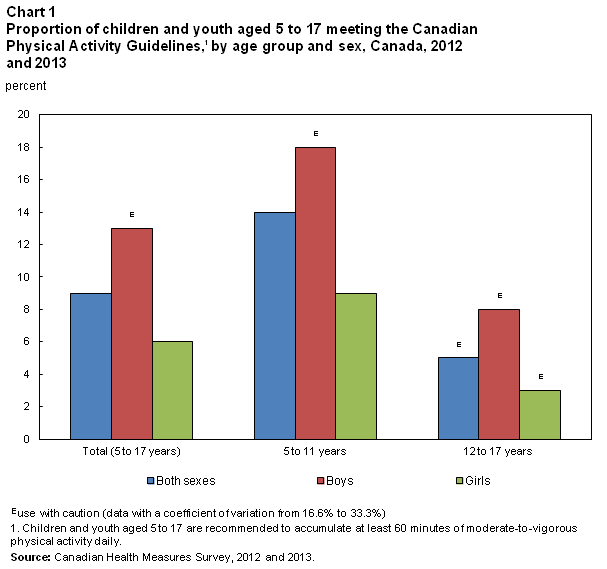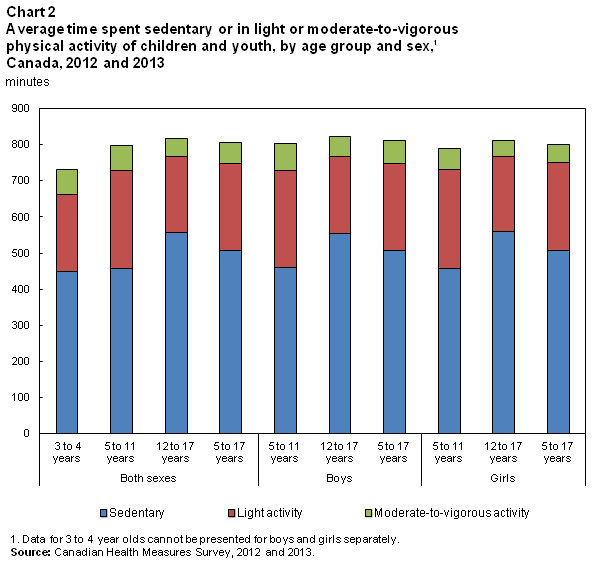Directly measured physical activity of children and youth, 2012 and 2013
Archived Content
Information identified as archived is provided for reference, research or recordkeeping purposes. It is not subject to the Government of Canada Web Standards and has not been altered or updated since it was archived. Please "contact us" to request a format other than those available.

Correction Notice
On October 31, 2017, the text referring to the percentage of children meeting the physical activity guidelines or meeting other daily physical activity criteria was revised. The original text suggested that adherence to the Physical Activity Guidelines or other physical activity criteria was based on an individual's average daily level of physical activity. The following statements have been updated:
- In school-aged children and youth between the ages of 5 and 17, 13% of boys and 6% of girls were accumulating at least 60 minutes of moderate-to-vigorous physical activity daily as recommended in the guidelines (Chart 1).
- Furthermore, although the vast majority of 5- to 11-year-olds did not meet the physical activity guidelines, 39% achieved at least 30 minutes of moderate-to-vigorous physical activity daily (Chart 3). In 12- to 17-year-olds, 18% achieved at least 30 minutes.
The revised text better reflects the fact that the percent of the population adhering to a given criteria was determined by: a) calculating an individual's probability of meeting the criteria from individual daily values, and then b) computing the weighted average of the individual probabilities.
Regular physical activity and limited sedentary time for children and youth contribute independently to improvements in cholesterol levels, blood pressure, body composition, bone density, cardiorespiratory and musculoskeletal fitness, academic achievement, self-esteem as well as other aspects of mental health.Note 1,Note 2
Physical activity in school-aged children and youth
The majority of school-aged children and youth are not getting enough physical activity to meet the current Canadian Physical Activity Guidelines. In school-aged children and youth between the ages of 5 and 17, 13% of boys and 6% of girls were accumulating at least 60 minutes of moderate-to-vigorous physical activity daily as recommended in the guidelines (Chart 1). Girls aged 12 to 17 were least likely to get the recommended amount of activity (3%), whereas boys aged 5 to 11 were most likely to meet the guidelines for moderate-to-vigorous physical activity (18%).

Children and youth spend the majority of their time being sedentary. Children and youth aged 5 to 17 spent an average of 8 hours and 27 minutes, or nearly two-thirds of their waking hours, being sedentary each day (Chart 2).

Overall, youth aged 12 to 17 were significantly more sedentary and significantly less active than their 5- to 11-year-old counterparts. Youth were sedentary 9 hours and 16 minutes and engaged in 50 minutes of moderate-to-vigorous physical activity compared to children who were sedentary for 7 hours and 38 minutes and engaged in 67 minutes of moderate-to-vigorous physical activity (Chart 2). Furthermore, although the vast majority of 5- to 11-year-olds did not meet the physical activity guidelines, 39% achieved at least 30 minutes of moderate-to-vigorous physical activity daily (Chart 3). In 12- to 17-year-olds, 18% achieved at least 30 minutes.

The number of steps taken per day is another way to assess daily physical activity levels—children are recommended to take at least 12,000 steps per day. Again, the majority of children and youth are not taking enough. The proportion meeting the recommended 12,000 steps per day was 10% of boys and 6% of girls aged 5 to 17 (data not shown). Girls aged 12 to 17 were least likely to get 12,000 steps (3%), and boys aged 5 to 11 were most likely to get enough steps (14%) (data not shown).
Physical activity levels did not differ significantly by body mass index (BMI) for youth aged 12 to 17 (data not shown). For children aged 5 to 11 years, the proportion meeting the physical activity guidelines was significantly higher among those who were normal weight (15%) compared to those who were overweight or obese (10%) (data not shown).
Physical activity in pre-school aged children
Pre-school children aged 3 to 4 years accumulated 4 hours and 43 minutes of light or moderate-to-vigorous physical activity daily (Chart 2), and were sedentary 7 hours and 28 minutes of waking time. A large proportion of pre-school aged children (70%) had at least 180 minutes of total physical activity (light or moderate-to-vigorous intensity) daily (data not shown), which is in line with the Canadian Physical Activity Guidelines. While the majority of physical activity in this age group was of light intensity (Chart 2), 44% were getting at least 30 minutes of moderate-to-vigorous physical activity most days of the week (Chart 3). About 19% of 3- to 4-year-olds had at least 60 minutes of MVPA daily, which (as described above) is the recommended daily physical activity for older children and youth.
Physical activity levels did not differ significantly by body mass index for younger children 3 to 4 years (data not shown).
Start of text box
About physical activity
The Canadian Physical Activity Guidelines recommend that children and youth aged 5 to 17 accumulate at least 60 minutes of moderate-to-vigorous intensity aerobic physical activity (MVPA) per day in order to achieve health benefits.Note 1 This can be accomplished through bike riding, playground activities, running, swimming, etc.Note 1 The Canadian Physical Activity Guidelines also recommend that children aged 3 to 4 should accumulate at least 180 minutes of physical activity at any intensity throughout the day, with the target of progressing towards at least 60 minutes of MVPA per day by 5 years of age.
The activity monitor was worn on an elasticized belt over the right hip. An activity monitor measures the acceleration of movement, recording it as a count per minute (cpm) value. The cpm values provide information on the amount of time spent being sedentary, in light activity, and in moderate-to-vigorous physical activity. The activity monitor also captures step counts per day, which is another measure that can be used to assess physical activity levels in children and youth.Note 3
End of text box
Notes
References
Canadian Society for Exercise Physiology. Canadian Physical Activity Guidelines. Ottawa, ON. 2011. www.csep.ca/guidelines. (accessed: March 1, 2012).
Colley R.C., Janssen I., Tremblay M.S. “Daily step target to measure adherence to physical activity guidelines in children.” Medicine and Science in Sports and Exercise. 2012. Vol. 44, no. 5, p. 977 to 982.
de Onis, M., Onyango, A.W., Borghi, E., Siyam, A., Nishida, C., and J. Siekmann. 2007. “Development of a WHO growth reference for school-aged children and adolescents.” Bulletin of the World Health Organization Vol. 85, no. 9.
Janssen I., Leblanc A. “A systematic review of the health benefits of physical activity and fitness in school-aged children and youth.” International Journal of Behaviour, Nutrition and Physical Activity. 2010; Vol. 7, no. 40.
Tremblay M.S., Allana A.G., Janssen I., Kho M.E., Hicks A., Murumets K., Colley R.C., Duggan M. “Canadian Sedentary Behaviour Guidelines for Children and Youth.” Applied Physiology, Nutrition, and Metabolism. 2011. Vol. 36, p. 59 to 64.
- Date modified:
